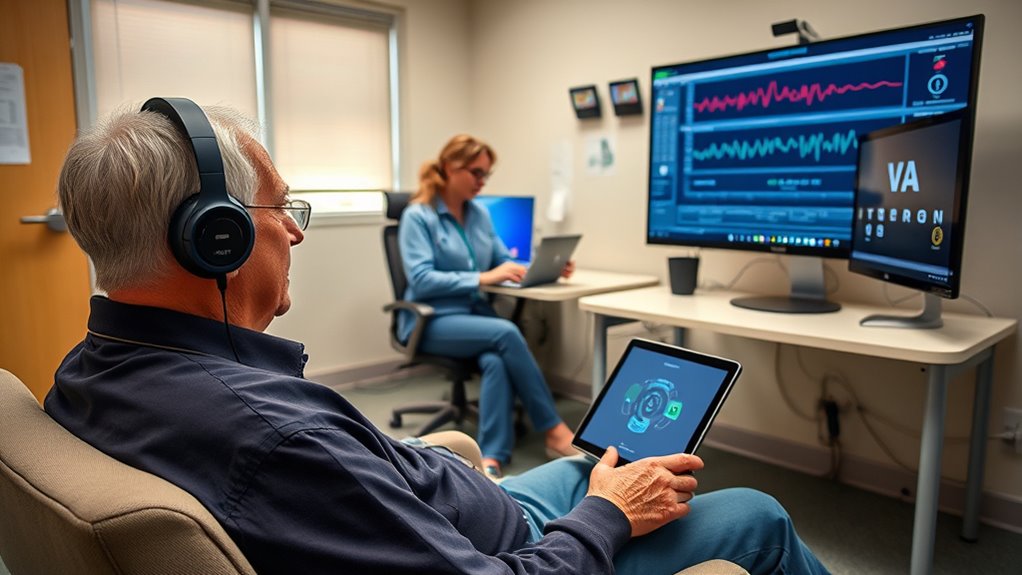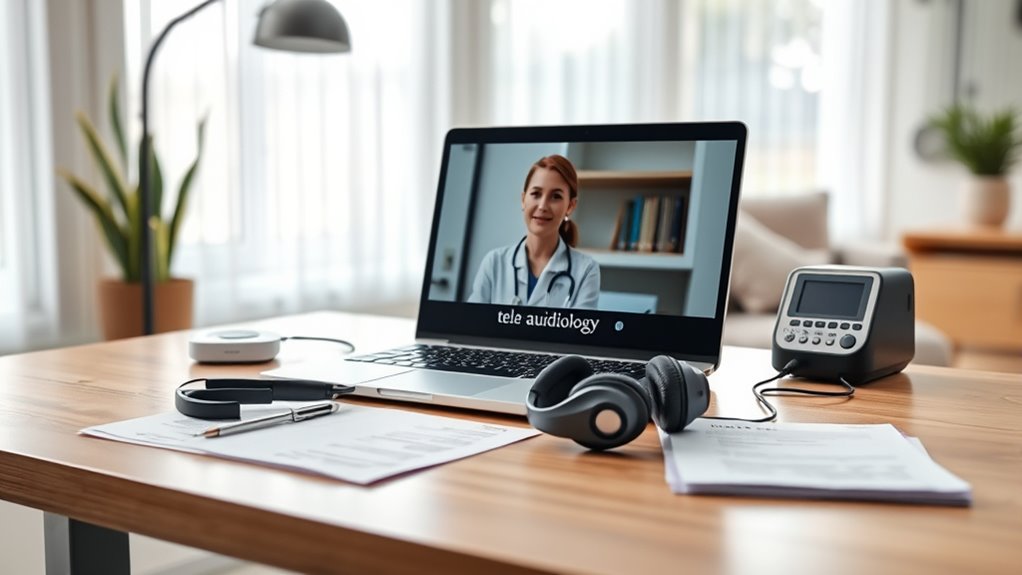To get VA tele-audiology services approved, start by requesting a referral from your VA healthcare provider. They will coordinate your hearing assessment and verify your home setup meets necessary requirements like internet and quiet space. Once approved, you can schedule remote evaluations that use secure technology to connect you with audiologists. This process removes travel barriers and makes access easy. Keep exploring to discover more about how you can benefit from this convenient hearing care option.
Key Takeaways
- Obtain a referral from your VA healthcare provider to start the approval process.
- Ensure your home setup meets internet and environment requirements for accurate testing.
- Coordinate with your VA facility to schedule a tele-audiology appointment.
- Follow pre-appointment instructions for equipment setup and testing procedures.
- Verify privacy and technical compatibility to facilitate a smooth remote hearing assessment.

Have you ever wondered how veterans access audiology services without leaving their homes? Thanks to VA tele-audiology, you can now receive expert hearing care remotely, making it easier to manage hearing issues without the inconvenience of travel. The process begins with hearing assessments, which are essential for diagnosing your hearing health. These assessments are performed using specialized audiology equipment that’s designed for remote use, guaranteeing accurate results even from a distance. The VA employs advanced telehealth technology to connect you with audiologists who can conduct thorough evaluations through secure video platforms.
When you opt for VA tele-audiology, the audiology equipment involved plays a critical role. Typically, the equipment includes high-quality microphones, headphones, and calibration tools that are set up at your home or a local VA facility. This equipment allows audiologists to perform tests such as pure-tone audiometry and speech recognition assessments just as they would in a clinic. The data collected is transmitted securely to your provider, who can analyze it in real-time. This setup guarantees your hearing assessments are detailed, accurate, and efficient, all without the need to visit an outpatient center physically.
The VA takes extensive measures to guarantee the tele-audiology process is seamless and trustworthy. Before your appointment, you’ll receive instructions on how to set up the audiology equipment correctly, ensuring the best possible performance. The audiologist guides you through the process via video, providing real-time support and making adjustments as needed. This interactive approach helps replicate the in-clinic experience, so you’re comfortable and confident in the assessment’s accuracy. The technology used is designed to minimize errors, provide clear audio signals, and protect your privacy throughout the process. Additionally, the use of remote work strategies has supported the expansion of telehealth services, ensuring veterans can access care regardless of their location.
Getting remote care approved is straightforward. You typically need to have a VA healthcare provider refer you to tele-audiology services. Once approved, your provider will coordinate your hearing assessments and schedule your appointments. You might also need to confirm your home setup meets technical requirements, such as a stable internet connection and a quiet environment. The VA’s goal is to make this process as accessible as possible, removing barriers like transportation or mobility issues. With tele-audiology, you can receive high-quality hearing assessments and ongoing care from the comfort of your home, ensuring your hearing health is maintained without added stress or inconvenience.
Frequently Asked Questions
How Do I Schedule a VA Tele-Audiology Appointment?
To schedule a VA tele-audiology appointment, contact your local VA clinic or use the VA appointment system online. Prepare for your appointment by exploring hearing device options and gathering any relevant medical history. Make sure your technology is ready, with a reliable internet connection and compatible device. During the call, discuss your hearing concerns and ask about the best hearing device options for your needs.
What Technology Do I Need for Remote Audiology Care?
For remote audiology care, you’ll need a reliable internet connection, a compatible device like a smartphone, tablet, or computer, and a microphone and speakers or headphones. Telehealth training can help you understand how to use remote hearing devices effectively. Make sure your equipment meets VA security standards, and check if your provider offers technical support to troubleshoot any issues during your tele-audiology sessions.
Are There Any Costs Associated With VA Tele-Audiology Services?
You might wonder if there are costs for VA tele-audiology services. Typically, the VA covers these services, so there are usually no out-of-pocket expenses for eligible veterans. However, it’s important to be aware of cost considerations and billing procedures, especially if additional services or equipment are involved. Always check with your VA provider beforehand to confirm coverage details and avoid surprises.
How Is Patient Privacy Protected During Remote Sessions?
During remote sessions, your privacy is protected through data encryption, which secures your information from unauthorized access. The tele-audiology providers also follow strict privacy policies to ensure your personal health data remains confidential. These measures help prevent breaches and keep your conversations private. You can trust that your remote care sessions are designed to safeguard your privacy while providing quality audiology services.
Can I Switch Between In-Person and Tele-Audiology Care Easily?
Switching between in-person and tele-audiology care is like changing gears smoothly in a car; it’s designed for your appointment flexibility. You can easily shift as your needs evolve, ensuring seamless care. Many veterans find this care transition convenient, allowing them to stay comfortable while maintaining consistent treatment. Talk to your provider about scheduling options, so your audiology care adapts effortlessly to your lifestyle and preferences.
Conclusion
You now see how VA tele-audiology is breaking down barriers and bringing care directly to your doorstep. By embracing this remote option, you’re not just keeping up with technology—you’re taking charge of your hearing health. Remember, the proof is in the pudding, so don’t hesitate to explore tele-audiology services. It’s a win-win situation—convenience and quality care, all without leaving your comfort zone. Now’s the time to give it a shot!











